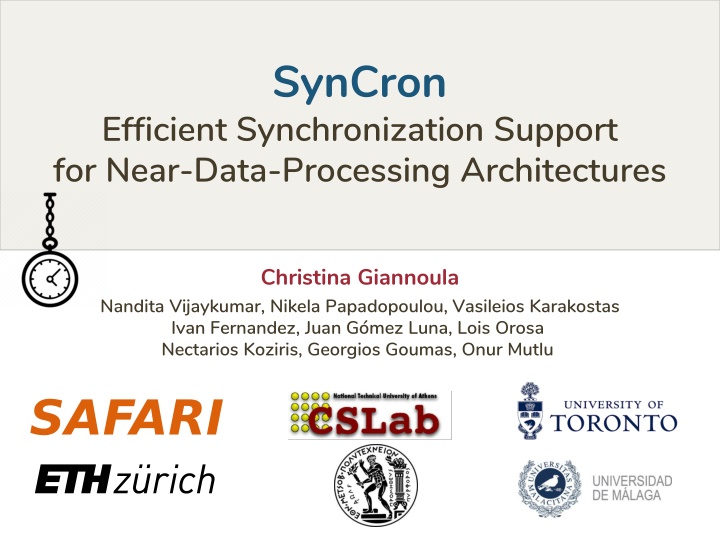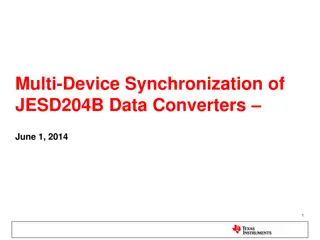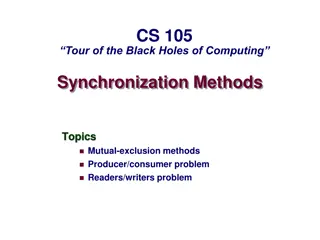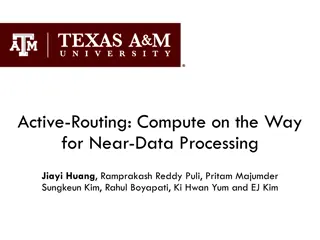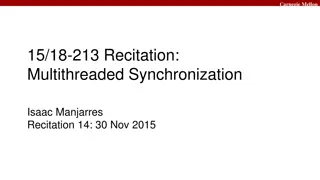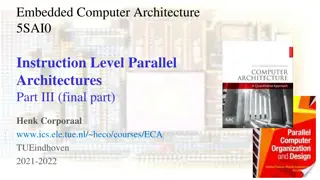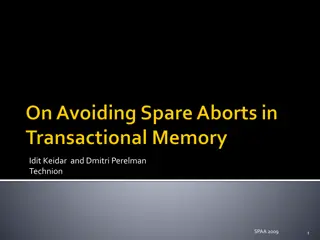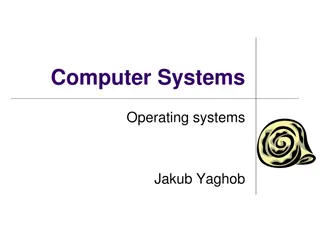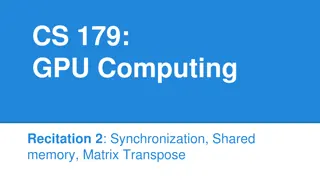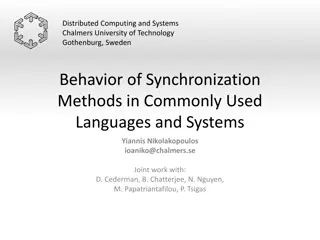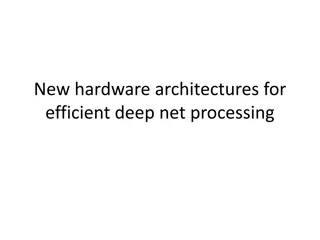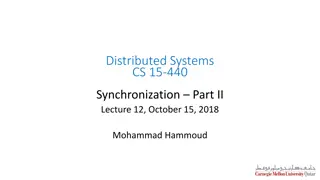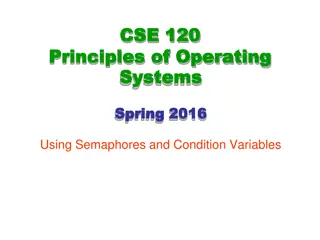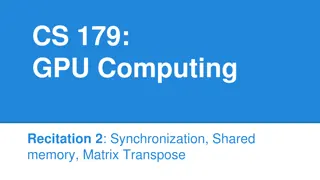Efficient Synchronization Support for Near-Data-Processing Architectures
Synchronization challenges in near-data-processing systems are addressed by SynCron, providing an end-to-end solution for efficient synchronization in NDP architectures, improving performance and energy utilization. The solution involves shared memory, hardware cache coherence, software-based schemes, and specialized hardware support.
Download Presentation

Please find below an Image/Link to download the presentation.
The content on the website is provided AS IS for your information and personal use only. It may not be sold, licensed, or shared on other websites without obtaining consent from the author.If you encounter any issues during the download, it is possible that the publisher has removed the file from their server.
You are allowed to download the files provided on this website for personal or commercial use, subject to the condition that they are used lawfully. All files are the property of their respective owners.
The content on the website is provided AS IS for your information and personal use only. It may not be sold, licensed, or shared on other websites without obtaining consent from the author.
E N D
Presentation Transcript
SynCron Efficient Synchronization Support for Near-Data-Processing Architectures Christina Giannoula Nandita Vijaykumar, Nikela Papadopoulou, Vasileios Karakostas Ivan Fernandez, Juan G mez Luna, Lois Orosa Nectarios Koziris, Georgios Goumas, Onur Mutlu
Executive Summary Problem: Synchronization support is challenging for NDP systems Prior schemes are not suitable or efficient for NDP systems Contribution: SynCron: the first end-to-end synchronization solution for NDP architectures Key Results: SynCron comes within 9.5% and 6.2% of performance and energy of an Ideal zero-overhead synchronization scheme 2
Near-Data-Processing (NDP) Systems NDP Logic CPU Recommendation Systems Graph Analytics Neural Networks Bioinformatics 3
Synchronization is Necessary Image Processing Bioinformatics Graph Analytics Databases Single Source Shortest Path (SSSP) Barriers Locks for v in Graph: for u in neighbors[v]: if distance[v] + edge_weight[v, u] < distance[u] if distance[v] + edge_weight[v, u] < distance[u] distance[u] = distance[v] + edge_weight[v, u] lock_release(u) Concurrent Data Structures lock_acquire(u) 4
Baseline NDP Architecture NDP System NDP Unit Programmable Core / Accelerator NDP Core Main Memory NDP Core Private Cache NDP Core Synchronization challenges in NDP systems: (1) Lack of hardware cache coherence support (2) Expensive communication across NDP units (3) Lack of a shared level of cache memory 5
NDP Synchronization Solution Space (2) Message-passing (1) Shared Memory Hardware Cache Coherence Software- based Schemes Specialized Hardware Support Remote Atomics Specialized Hardware Support 6
NDP Synchronization Solution Space (2) Message-passing (1) Shared Memory Hardware Cache Coherence Software- based Schemes Specialized Hardware Support Remote Atomics Specialized Hardware Support CPUs: Hierarchical CLH Locks [EuroPar 06] Cohort Locks [TOPC 15] Ticket Locks [TOCS 91] MPPs: QOLB [ASPLOS 89] Lack of hardware cache coherence support 7
NDP Synchronization Solution Space (2) Message-passing (1) Shared Memory Hardware Cache Coherence Software- based Schemes Specialized Hardware Support Remote Atomics Specialized Hardware Support CPUs: MiSAR [ISCA 15] LCU [MICRO 10] Glocks [IPDPS 11] GPUs: HQL [IPDPS 13] GPUs: Fermi GF100 [IEEE Micro 10] MPPs: SGI Origin [ISCA 97] Cray T3E [ASPLOS 96] CPUs: SSB [ISCA 07] Lock Cache [CASES 01] MPPs: Full/Empty Bits [ISCA 83] NDPs: Tesseract [ISCA 15] Expensive communication across NDP units 8
NDP Synchronization Solution Space (2) Message-passing (1) Shared Memory Hardware Cache Coherence Software- based Schemes Specialized Hardware Support Remote Atomics Specialized Hardware Support CPUs: SSB [ISCA 07] Lock Cache [CASES 01] BarrierFilter [MICRO 06] CPUs: MiSAR [ISCA 15] GPUs: HQL [IPDPS 13] NDPs: Tesseract [ISCA 15], Near-Data Processing for In-memory Analytics [PACT 15] Lack of a shared level of cache memory 9
NDP Synchronization Solution Space (2) Message-passing (1) Shared Memory Hardware Cache Coherence Software- based Schemes Specialized Hardware Support Remote Atomics Specialized Hardware Support Prior schemes are not suitable or efficient for NDP systems 10
NDP Synchronization Solution Space (2) Message-passing (1) Shared Memory Hardware Cache Coherence Software- based Schemes Specialized Hardware Support Remote Atomics Specialized Hardware Support NDPs: SynCron s Key Techniques: 1. Hardware support for synchronization acceleration 2. Direct buffering of synchronization variables 3. Hierarchical message-passing communication 4. Integrated hardware-only overflow management SynCron [HPCA 21] 11
1. Hardware Synchronization Support NDP Unit 0 NDP Unit 1 NDP Core 0 NDP Core 0 ` ` ` ` ` ISA Main Memory Main Memory NDP Core 1 NDP Core 1 Synchronization Engine 0 Synchronization Engine 1 Local lock acquire No Complex Cache Coherence Protocols No Expensive Atomic Operations Low Hardware Cost 12
2. Direct Buffering of Variables NDP Unit 0 NDP Unit 1 NDP Core 0 NDP Core 0 Main Memory Main Memory NDP Core 1 NDP Core 1 Synchronization Engine 0 Synchronization Engine 1 Address Synchronization Table Local Synchronization Processing Unit -- lock acquire -- Indexing Counters -- -- 13
2. Direct Buffering of Variables NDP Unit 0 NDP Unit 1 NDP Core 0 NDP Core 0 Main Memory Main Memory NDP Core 1 NDP Core 1 Synchronization Engine 0 Synchronization Engine 1 Address Synchronization Table Local Synchronization Processing Unit 0x33A9 lock acquire No Costly Memory Accesses Low Latency -- Indexing Counters -- -- 14
3. Hierarchical Communication NDP Unit 0 NDP Unit 1 NDP Core 0 NDP Core 0 Main Memory Main Memory syncronVar NDP Core 1 NDP Core 1 Synchronization Engine 0 Synchronization Engine 1 NDP Unit 2 NDP Unit 3 NDP Core 0 NDP Core 0 Main Memory Main Memory NDP Core 1 NDP Core 1 Synchronization Engine 2 Synchronization Engine 3 15
3. Hierarchical Communication Local lock acquire NDP Unit 0 NDP Unit 1 NDP Core 0 NDP Core 0 Main Memory Main Memory syncronVar NDP Core 1 NDP Core 1 Synchronization Engine 0 Synchronization Engine 1 Master NDP Unit 2 NDP Unit 3 NDP Core 0 NDP Core 0 Main Memory Main Memory NDP Core 1 NDP Core 1 Synchronization Engine 2 Synchronization Engine 3 16
3. Hierarchical Communication Global lock acquire NDP Unit 0 NDP Unit 1 NDP Core 0 NDP Core 0 Main Memory Main Memory syncronVar NDP Core 1 NDP Core 1 Synchronization Engine 0 Synchronization Engine 1 Master NDP Unit 2 NDP Unit 3 NDP Core 0 NDP Core 0 Main Memory Minimize Expensive Traffic Main Memory NDP Core 1 NDP Core 1 Synchronization Engine 2 Synchronization Engine 3 17
4. Integrated Overflow Management NDP Unit 0 NDP Unit 1 NDP Core 0 NDP Core 0 Main Memory Main Memory syncronVar NDP Core 1 NDP Core 1 Synchronization Engine 0 Synchronization Engine 1 Fully Occupied Master Address 0x33A9 0x2241 0x438C 0x6B4A Synchronization Table Low Performance Degradation High Programming Ease Synchronization Processing Unit Indexing Counters 18
SynCron The first end-to-end synchronization solution for NDP architectures SynCron s Benefits: 1. High System Performance 2. Low Hardware Cost 3. Programming Ease SynCron comes within 9.5% and 6.2% of performance and energy of Ideal zero-overhead synchronization 4. General Synchronization Support 19
SynCron Efficient Synchronization Support for Near-Data-Processing Architectures Christina Giannoula Nandita Vijaykumar, Nikela Papadopoulou, Vasileios Karakostas Ivan Fernandez, Juan G mez Luna, Lois Orosa Nectarios Koziris, Georgios Goumas, Onur Mutlu
